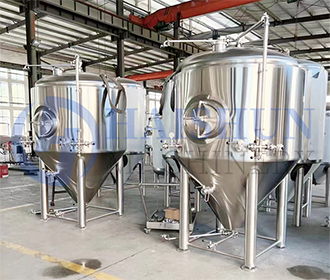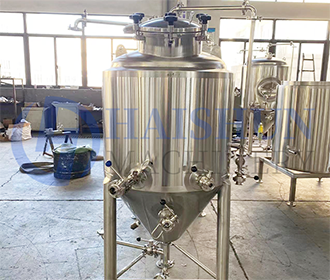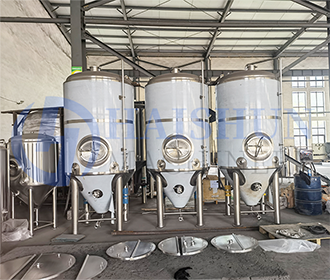Fermentation is a crucial process in the production of various products, including beer, wine, yogurt, and cheese. However, did you know that the design of fermentation tanks can significantly impact the quality of these final products? A well-designed tank can improve flavor profiles and increase efficiency while a poorly designed one can lead to contamination and off-flavors. In this blog post, we will dive into the different types of fermentation tanks and their impact on product quality. So grab yourself a drink (fermented or not), sit back, and let's explore how tank design truly matters!
The different types of fermentation tanks
Fermentation tanks come in a variety of shapes and sizes, each tailored to the specific needs of different products. The most common types of fermentation tanks are open-top fermenters, closed-top fermenters, and conical-bottomed fermenters.Open-top fermenters allow for greater airflow during fermentation, which can enhance the flavor profile of certain products such as wine. Closed-top fermenters are sealed off from outside air, making them ideal for beer production where unwanted bacteria or oxygen could spoil the product.Conical-bottomed fermenters have become increasingly popular due to their ability to collect sediment at the bottom of the tank while allowing for easy removal through a valve. This design makes cleaning and maintenance more manageable while also providing better control over temperature regulation during fermentation.Additionally, some manufacturers offer custom-designed tanks with unique features such as built-in cooling systems or mixing capabilities that cater to specific production requirements. Ultimately, choosing a suitable type of fermentation tank is critical in achieving optimal quality final products.

The impact of tank design on fermentation
When it comes to brewing and fermentation, the design of the tank used plays a crucial role in determining the quality of the final product. The dimensions, materials, and features of the tank can all impact how well your brew ferments.One important factor is temperature control. A well-designed fermentation tank will have insulation to keep temperatures stable throughout the process. This ensures consistent results every time you brew.Another key aspect is oxygenation. Aerating your wort at specific stages during fermentation can help yeast cells grow more efficiently and produce a better-tasting beer or other fermented product. A good tank design will incorporate features such as ports for oxygen delivery.The shape of the tank also matters. Cylindrical tanks are ideal for even heat distribution and better yeast circulation because they promote natural convection currents that aid in mixing ingredients evenly throughout.Sanitation is critical for any fermenting vessel. Tanks with smooth surfaces reduce areas where bacteria can hide, making them easier to clean thoroughly between batches.By carefully considering these factors when choosing a fermentation tank, brewers can ensure that their final products meet their desired flavor profiles consistently while reducing costs associated with spoiled batches due to poor equipment choices or inadequate maintenance procedures over time!
The benefits of a well-designed fermentation tank
A well-designed fermentation tank can bring numerous benefits to the brewing process. One of the main advantages is that it can help ensure consistency in the quality of the final product. A tank designed with proper insulation and temperature control features will maintain a constant environment for fermentation, which helps prevent fluctuations that could negatively impact yeast growth or flavor development.Another benefit is increased efficiency during both primary and secondary fermentation. Well-designed tanks typically have features such as conical bottoms and racking arms that make it easier to transfer beer from one stage of the process to another while minimizing waste or contamination risks.Additionally, a well-designed tank can also save time and labor costs by simplifying cleaning procedures. Tanks with smooth surfaces, rounded corners, and easily removable parts are easier to clean thoroughly than those with complicated designs or hard-to-reach areas.Investing in a high-quality fermentation tank may ultimately lead to cost savings over time due to its durability and longevity. A sturdy stainless steel tank built for long-term use will require less frequent repairs or replacements compared to cheaper options made from lower quality materials.Taking into account all these factors when choosing a fermentation tank will contribute positively towards creating high-quality brews consistently while improving overall production efficiency in your brewery operations.

The drawbacks of a poorly-designed fermentation tank
A poorly-designed fermentation tank can have a negative impact on the quality of the final product. One major drawback is contamination, which occurs when bacteria or other microorganisms enter the tank and spoil the contents.Another issue with poor design is uneven temperature distribution throughout the tank. This can lead to inconsistent fermentation, resulting in a subpar flavor profile or incomplete conversion of sugars into alcohol.In addition, inadequate ventilation in a poorly-designed tank can cause pressure build-up, leading to explosions and damage to both equipment and personnel. Poorly-placed valves and fittings can also contribute to this problem.Furthermore, tanks that are difficult to clean may harbor residue from previous batches that could compromise subsequent fermentations. A lack of proper drainage or filtration systems may also make it challenging to remove unwanted particles from the brew.Investing in a well-designed fermentation tank will not only improve product quality but also enhance safety measures for staff operating near these vessels.
How to choose the right fermentation tank for your needs
Choosing the right fermentation tank is critical to ensure that your final product meets your desired quality standards. There are several factors to consider when selecting a fermentation tank, including size, material, temperature control and agitation.Firstly, it's important to determine the volume of beer you want to produce based on demand and space available in your brewery. You should select a tank with enough capacity to meet current demands but also have room for expansion if needed.Secondly, consider the type of material used for fabrication. Stainless steel is often preferred due to its durability and ease of cleaning. However, other materials such as plastic or wood may be suitable depending on your specific brewing requirements.Temperature control is another crucial factor in choosing a fermentation tank. Ensure that the design allows for precise temperature regulation throughout the entire fermenting process to maintain consistency in flavor and aroma profiles.Agitation plays an essential role in ensuring consistent yeast activity during fermentation. Look for tanks with proper mixing systems or choose designs that naturally promote circulation within the vessel.In summary, selecting the right fermentation tank requires careful consideration of several factors such as volume requirements, material choice, temperature control and agitation capabilities. By identifying these key elements early on in your selection process will help ensure that you can produce high-quality beer consistently over time while maximizing efficiency within your brewery operations.

Conclusion
To sum it up, the design of a fermentation tank plays an essential role in achieving high-quality end products. From selecting the right type of tank, to considering various design factors such as material, size, shape and orientation - everything counts towards producing superior quality fermented beverages or foods. A well-designed fermentation tank ensures optimal conditions for yeast or bacteria growth while minimizing the risk of contamination and oxidation.On the other hand, a poorly-designed fermentation tank can lead to subpar results such as off-flavors, low yields and inconsistent batches. Therefore, it's crucial for brewers and food manufacturers to choose their tanks wisely based on their specific needs and goals.Investing in a well-designed fermentation tank is worth every penny if you want to produce top-notch fermented products that stand out from the competition. With proper planning and research beforehand, you can find the perfect match between your requirements and available options in terms of cost-effectiveness, durability and performance. So go ahead - raise a glass (or spoon) to good design!
